Bathroom renovations can be a headache. Are you tired of floors that buckle or grow mold? Discover how to pick flooring that truly lasts.
Choosing optimal bathroom flooring means prioritizing 100% waterproof materials like SPC or LVT vinyl. These options resist moisture, prevent mold, and offer superior durability. This ensures a safe, hygienic, and long-lasting surface for any wet environment, making them ideal for both residential and commercial spaces.
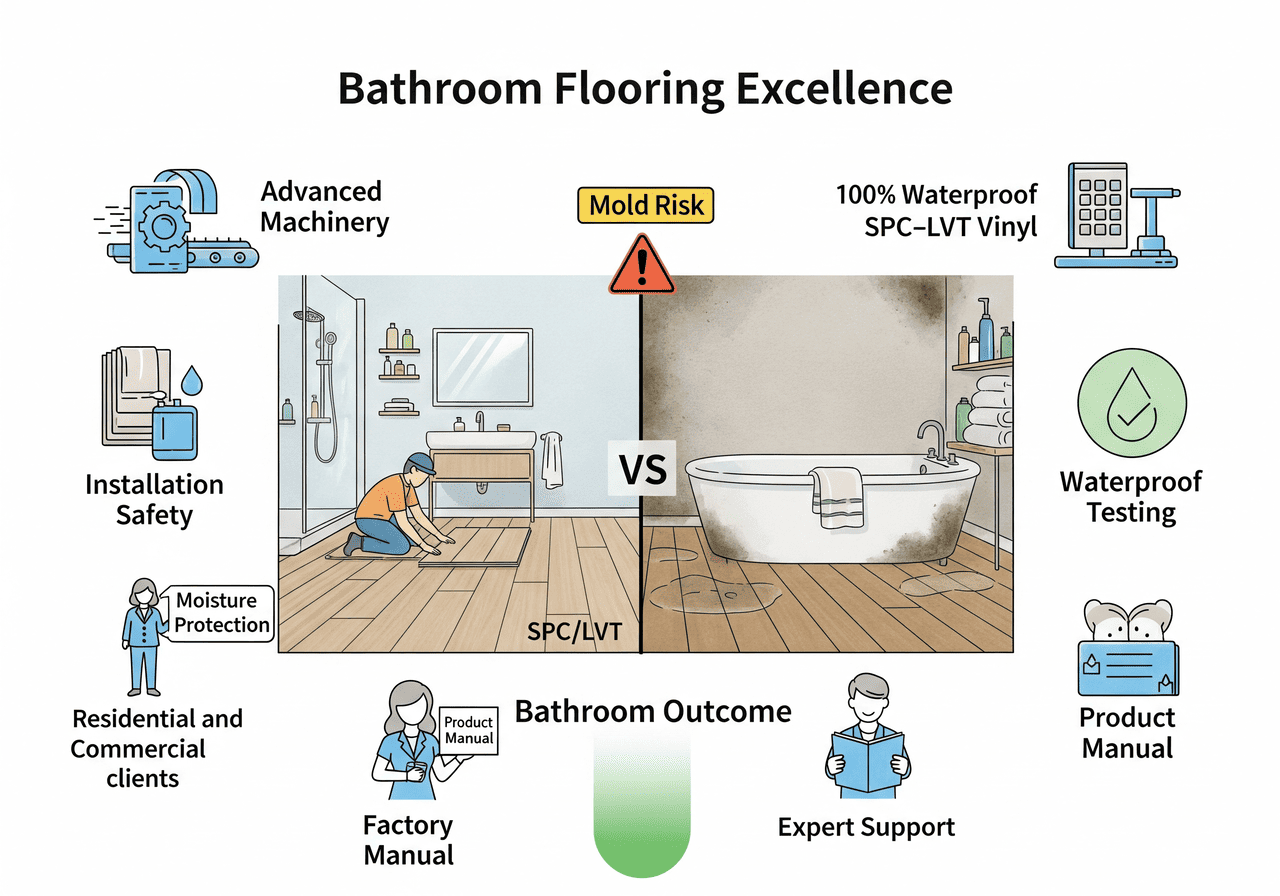
Selecting the right flooring for a bathroom is not just about looks. It is about function, safety, and long-term value. As Jessica from CloudsFlooring, I have seen many projects. Picking the wrong material leads to big problems. This guide will help you understand why waterproof vinyl flooring is often the best choice. It will also show you how to pick the right type for your needs, ensuring it stands up to frequent water exposure.
Your Guide to Optimal Bathroom Flooring Choices
Choosing the right flooring for bathrooms in 2025 requires prioritizing waterproofing, safety, hygiene, and style. This guide outlines key considerations for residential and commercial bathrooms. It focuses on performance, aesthetics, and compliance.
Key Selection Criteria
- Waterproofing1: Must be 100% waterproof to handle spills, splashes, and humidity.
- Safety: Slip-resistant surfaces2 to prevent falls in wet conditions.
- Hygiene: Non-porous materials3 to resist mold and bacteria growth.
- Durability: Withstands heavy use, scratches, and wear.
- Maintenance: Easy to clean with minimal upkeep.
- Aesthetics: Realistic designs mimicking wood, stone, or tile.
- Commercial Compliance: Meets slip resistance and health standards for commercial use.
Steps to Select
- Assess Environment: Evaluate moisture levels and traffic (residential vs. commercial).
- Prioritize Waterproofing: Choose LVP, LVT, or porcelain for full water resistance.
- Check Safety Features: Ensure slip resistance (e.g., PTV ≥45 for commercial).
- Evaluate Durability: Select products with thick wear layers (e.g., 20 mil).
- Consider Aesthetics: Opt for designs that match modern bathroom trends.
- Verify Installation: Confirm click-lock systems and moisture barriers are used.
- Ensure Compliance: Check certifications like FloorScore or ADA compliance.
- Compare Costs: Balance initial cost with long-term durability and maintenance.
This guide helps select bathroom flooring that is durable, safe, and stylish. Now, let’s dive deeper into each of these points.
Why Is 100% Waterproof Performance Non-Negotiable For Bathroom Flooring?
Water damage causes major problems. Are you wondering if your current floor can handle splashes? Learn why being fully waterproof is the only way to go.
Waterproof performance is essential for bathroom flooring. Research shows that 100% waterproof flooring1 is critical to prevent damage from frequent water exposure. Without it, moisture can quickly damage the floor and subfloor, leading to costly repairs and unhealthy conditions.
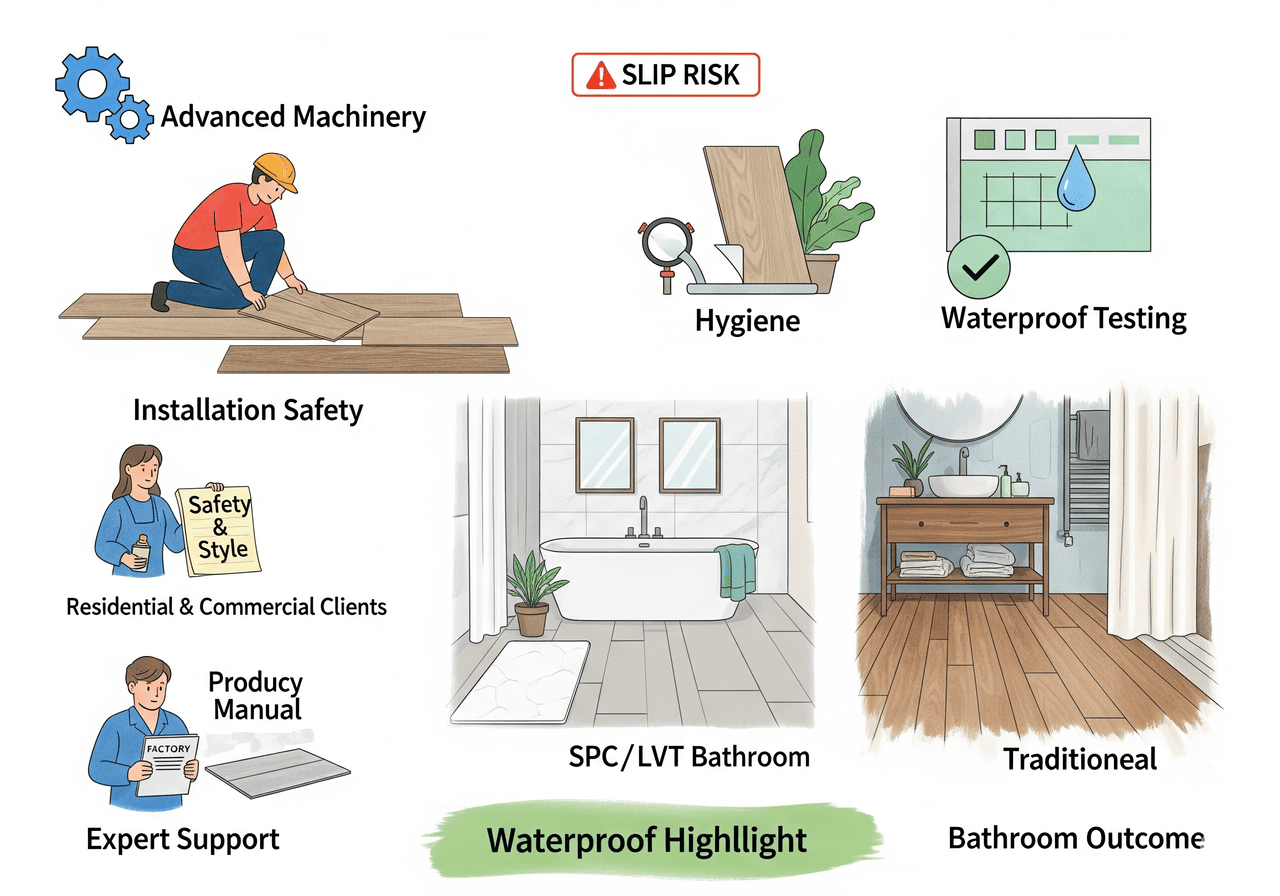
Understanding Water Damage Risks
Bathrooms are high-moisture environments. Water from showers, baths, sinks, and high humidity is always present. A floor that absorbs water can lead to severe issues. Materials like hardwood or traditional laminate can swell or warp when exposed to water. This causes uneven surfaces and aesthetic damage. I have seen many cases where clients had to replace floors too soon because they weren’t truly waterproof.
Moisture trapped in flooring or subfloors fosters mold and mildew growth. This can pose serious health risks and require costly remediation. Water seeping through seams can damage wood or concrete subfloors, leading to rot or structural problems. These issues are expensive to fix. Damaged flooring and subfloors always require expensive replacements. This increases long-term costs for my B2B clients, and for their customers.
Waterproof flooring, such as luxury vinyl plank (LVP), luxury vinyl tile (LVT), and porcelain tile, is designed to withstand standing water and humidity without damage. For example, SPC (Stone Plastic Composite) vinyl has a dense core that repels water effectively. This makes it ideal for bathrooms. My factory specializes in SPC and LVT. We focus on ensuring a 100% waterproof core. This prevents all these common problems. This is why large company buyers, like Aiden in the UK, prioritize our products. They need reliability.
Here is a quick look at water absorption:
| Flooring Type | Moisture Absorption Rate (Typical) | Suitability for Bathrooms | Risks if Not Waterproof |
|---|---|---|---|
| Hardwood | High | Not Recommended | Swelling, rot, mold |
| Laminate (non-waterproof) | Medium to High | Not Recommended | Delamination, buckling |
| Ceramic/Porcelain Tile | Very Low (grout can absorb) | Good (if properly sealed) | Grout mold, lifting |
| SPC/LVT Vinyl | 0% (100% waterproof core) | Excellent | None |
Proper installation is also crucial to prevent water seepage through seams. This ensures the flooring’s waterproof performance is maintained. We always advise our buyers on best practices.
How Does Vinyl Flooring Ensure Safety, Hygiene, And Easy Maintenance In Bathrooms?
Worried about slippery floors or tough cleaning? Are you looking for a flooring solution that keeps your bathroom clean and safe? See how vinyl flooring helps.
Vinyl flooring is great for bathrooms because of its many benefits. It offers good slip resistance. This makes it safer, especially when wet. Its non-porous surface also means it does not absorb spills. This makes it hygienic and easy to clean, requiring minimal upkeep.
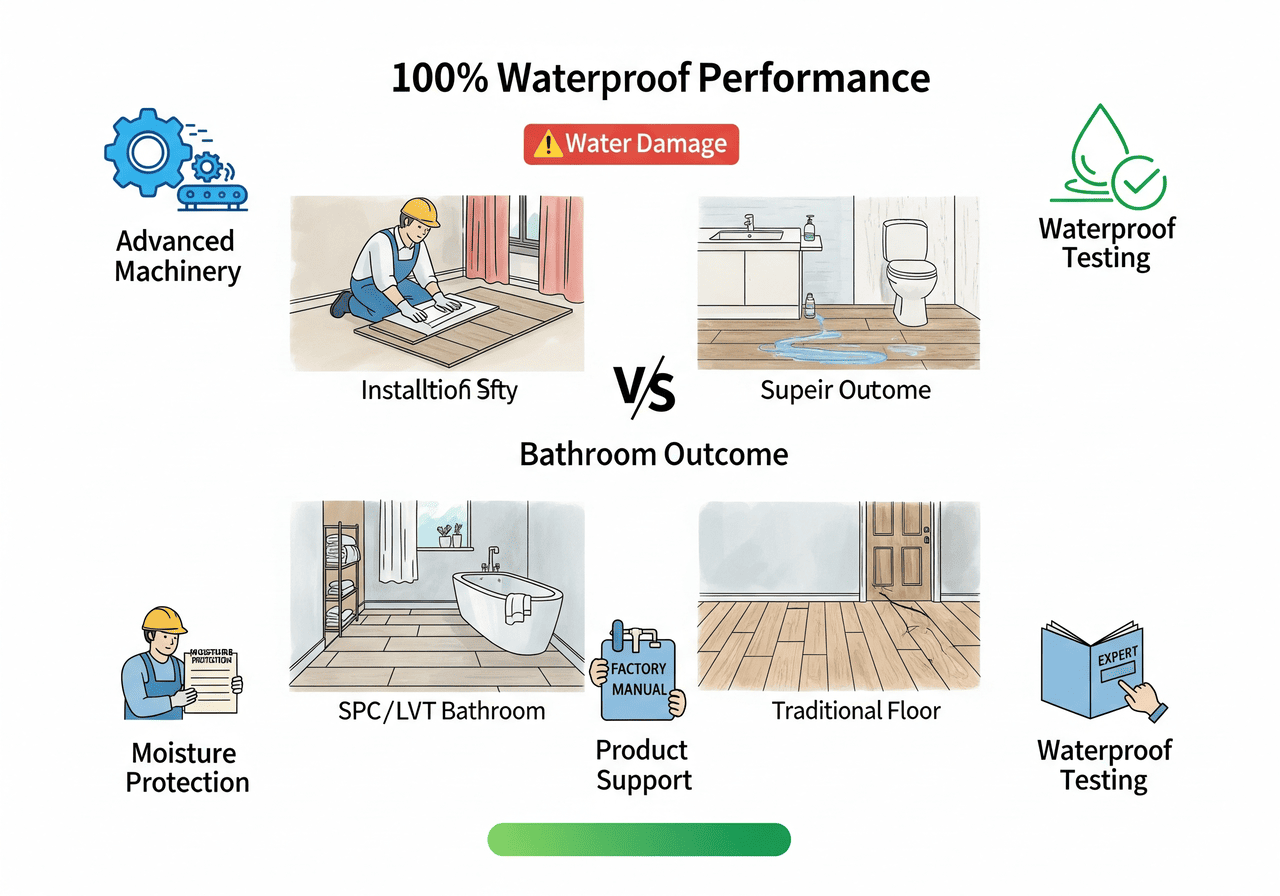
Key Features for Bathroom Performance
Vinyl flooring, especially LVP and LVT, excels in bathrooms. It addresses safety, hygiene, and maintenance needs very well. For safety, vinyl flooring often features textured or embossed surfaces. These enhance slip resistance1. This reduces the risk of falls in wet conditions. This is critical in bathrooms where water on the floor is common. Its durability and scratch resistance also ensure it remains intact under heavy use. This maintains a safe surface over time. My products are designed with this in mind for our clients.
For hygiene, being 100% waterproof is key. Vinyl prevents water absorption. This eliminates conditions for mold, mildew, or bacterial growth. It ensures a clean and healthy bathroom environment. Its non-porous surface2 also resists stains from toiletries, soaps, or other bathroom products. This maintains hygiene easily.
Vinyl requires minimal upkeep3. It only needs regular sweeping or mopping with a mild cleaner. Unlike hardwood or stone, it does not require sealing or refinishing. Spills can be wiped away easily without damaging the surface. This makes it ideal for busy households or commercial settings. Lori, a COO from the United States, focuses on products that are low-maintenance for her distribution. She values quality and efficiency for her customers.
Here is a comparison of cleaning and hygiene needs:
| Flooring Type | Cleaning Effort | Stain Resistance | Bacteria/Mold Resistance | Slip Resistance (Typical) |
|---|---|---|---|---|
| Vinyl | Low | High | High | Good (textured options) |
| Tile | Medium | Medium | Medium (grout issues) | Good (if textured) |
| Laminate | Medium | Low | Low | Moderate |
These properties make vinyl flooring a practical and reliable choice for bathrooms. They ensure safety and cleanliness with minimal effort. Our factory in China produces vinyl designed for easy care, which is a major selling point for my B2B clients.
What Design Trends Make Vinyl Flooring An Attractive Choice For Modern Bathrooms?
Do you think vinyl limits your style? Are you wondering how to make your bathroom look modern and chic? Explore how vinyl flooring matches the latest design trends.
Vinyl flooring has changed a lot. It is no longer just a basic option. Modern vinyl, especially LVT and SPC, offers a wide range of designs. It can mimic natural materials like wood or stone perfectly. This allows for beautiful and stylish bathroom spaces. Evidence leans toward realistic wood and stone designs. Seamless installations and eco-friendly options1 are key trends.
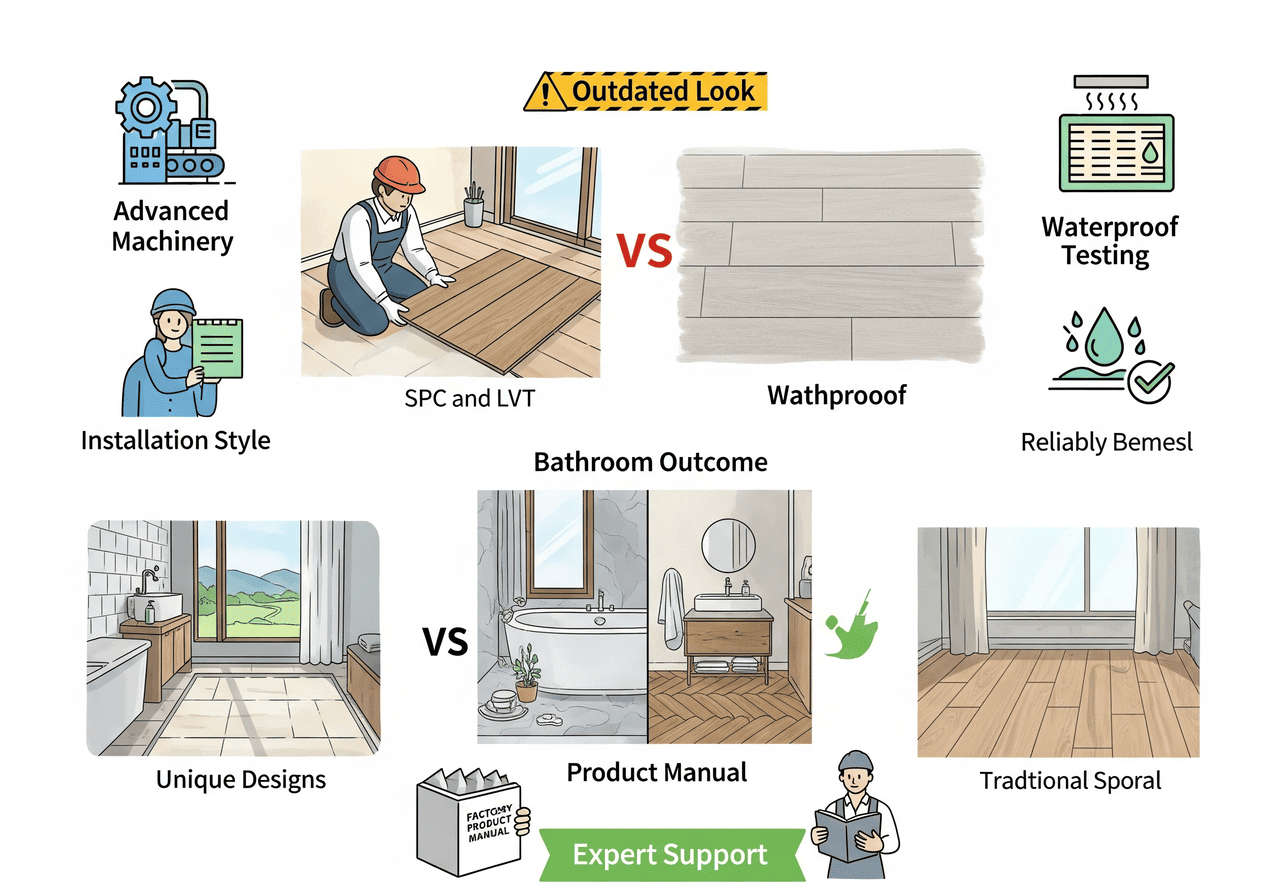
Achieving Aesthetic Goals with Vinyl
Vinyl flooring has become a top choice for modern bathrooms. This is due to its aesthetic versatility. It aligns with contemporary design trends. Advanced digital printing and embossing technologies allow vinyl to replicate the look and feel of hardwood. It can also mimic natural stone like marble or slate. It even copies ceramic tile. This enables homeowners to achieve a high-end aesthetic at a lower cost. For example, LVP can feature realistic wood grain textures. LVT can mimic stone or tile patterns with impressive detail.
Large-format planks, such as 7 inches wide by 48 inches long, or sheet vinyl, reduce visible seams. This creates a sleek, modern look. It also minimizes water seepage risks. Seamless designs enhance the clean, minimalist aesthetic popular in modern bathrooms. My factory offers these popular sizes.
Vinyl offers a wide range of colors. You can find light grays, dark charcoals, and everything in between. This allows customization to match any bathroom style. You can go from spa-like serenity to bold modernity. Many vinyl products now incorporate recycled materials. They also use sustainable manufacturing processes. This appeals to environmentally conscious consumers. Certifications like FloorScore ensure low VOC emissions, enhancing indoor air quality. Also, matte or low-gloss finishes are trending. They offer understated elegance. Textured surfaces add visual depth and improve slip resistance.
Many of my North American and UK clients, including Aiden, are always looking for new designs. They want products that stand out. They need both quality and unique styles to rebrand and sell at higher prices. From CloudsFlooring, we offer customizable logo and rare style options. This supports our clients’ needs for unique products.
Here are some popular design trends achievable with vinyl:
| Trend | Vinyl Feature | Example Look | Why It’s Popular (2025) |
|---|---|---|---|
| Natural Wood Look | Realistic wood grain, various finishes | Scandinavian, Farmhouse | Warmth, timeless appeal |
| Large Format Stone | Wide planks, tile patterns | Modern, Industrial | Sleek, minimalist vibe |
| Geometric Patterns | Specific tile shapes, custom cuts | Retro, Contemporary | Bold statement |
| Minimalist Grey Tones | Solid colors, subtle textures | Urban Chic, Spa-like | Serene, clean feel |
| Eco-Friendly | Recycled materials, low VOCs | Sustainable, healthy living | Environmental consciousness |
We understand that our B2B partners need to offer diverse choices. Our factory has invested in machines that make a wide range of designs. This lets our buyers meet their market demands.
Which Installation Techniques Maximize Water Resistance And Long-Term Durability For Bathroom Vinyl?
Are you concerned about your floor lasting? Do you wonder about the best way to install vinyl in a bathroom? Discover how proper installation makes a big difference.
Correct installation is just as important as the product itself. Even the best waterproof vinyl needs careful fitting. This ensures it performs well. It also prevents water from getting underneath. This maximizes its lifespan in a wet environment. Proper installation techniques, like water-tight seals and moisture barriers, are critical for vinyl’s durability.
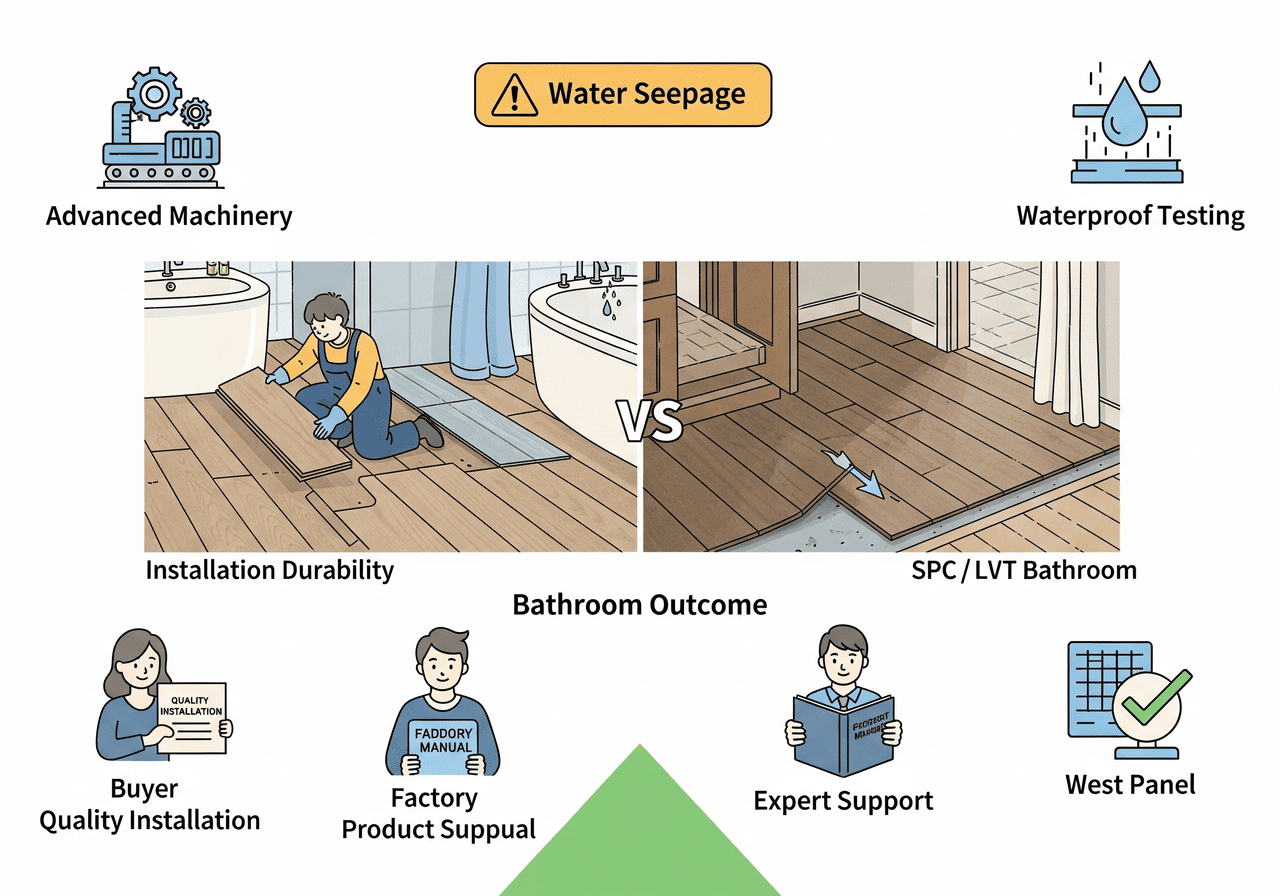
Best Practices for Vinyl Installation
For optimal water resistance, proper subfloor preparation is crucial. The subfloor must be clean, dry, and perfectly level. Any imperfections can affect the flooring’s integrity. For click-lock SPC or LVT, a tight, seamless fit is key. This prevents water from seeping through the joints. My factory manufactures products with precise click systems for this reason.
You should always choose vinyl with a truly waterproof core, such as SPC, which is highly resistant to moisture and dimensional changes. Using click-lock systems with water-tight seals1 is vital to prevent water from seeping through joints.
These systems ensure a secure fit and maintain waterproof integrity. I always recommend products that have passed rigorous tests, like the 100-Hour Water Test, which confirm their ability to withstand prolonged water exposure.
Installing a vapor barrier2 or moisture-resistant underlayment is also important. This protects the subfloor from moisture, especially on concrete subfloors. You must also apply a proper perimeter seal around the room’s edges. Use 100% silicone caulk where the flooring meets walls or fixtures. This stops water from running under the floor.
Some manufacturers, like Mohawk with their WetProtect® system, require this for warranty coverage. It’s crucial to follow the manufacturer’s installation instructions precisely. This includes acclimating the flooring to the bathroom’s temperature (65°F–85°F) and humidity (35%–55%) for 24–48 hours before installation. Ensure the subfloor is clean, level (within 3/16 inch per 10 feet), and dry to prevent issues like uneven surfaces or moisture damage.
At CloudsFlooring, we provide guidance on installation for our B2B partners. We know that a good product needs good installation. This helps our clients avoid common issues. We help them get the best performance from our LVT and SPC.
Consider these factors for installation:
| Installation Method | Key for Water Resistance | Durability Impact | Subfloor Prep Importance | Perimeter Sealing |
|---|---|---|---|---|
| Click-Lock | Tight, secure locking mechanisms | High, if planks are well-seated | High | Crucial |
| Dry Back (Glue Down) | Full, even adhesive coverage | Very High, if adhesive is correct | Very High | Crucial |
| Self-Adhesive | Clean, dry, smooth subfloor for bond | Medium, depends on bond strength | High | Recommended |
Our production lines for LVT and SPC are state-of-the-art. We ensure our products have precise dimensions. This helps with easy and correct installation. This helps our partners like Aiden, who care about quality control.
What Specific Regulations And Features Are Critical For Commercial Bathroom Safety?
Are you a commercial buyer worried about legal standards? Do you need to ensure your public bathrooms meet safety rules? Learn about critical regulations and features for commercial settings.
Commercial bathrooms face strict rules. These rules are about safety and hygiene. This is due to high traffic and public health concerns. Flooring in these areas needs to meet specific standards. These standards cover slip resistance, fire ratings, and durability. Commercial bathrooms likely require slip-resistant flooring meeting standards like PTV ≥45 for safety.
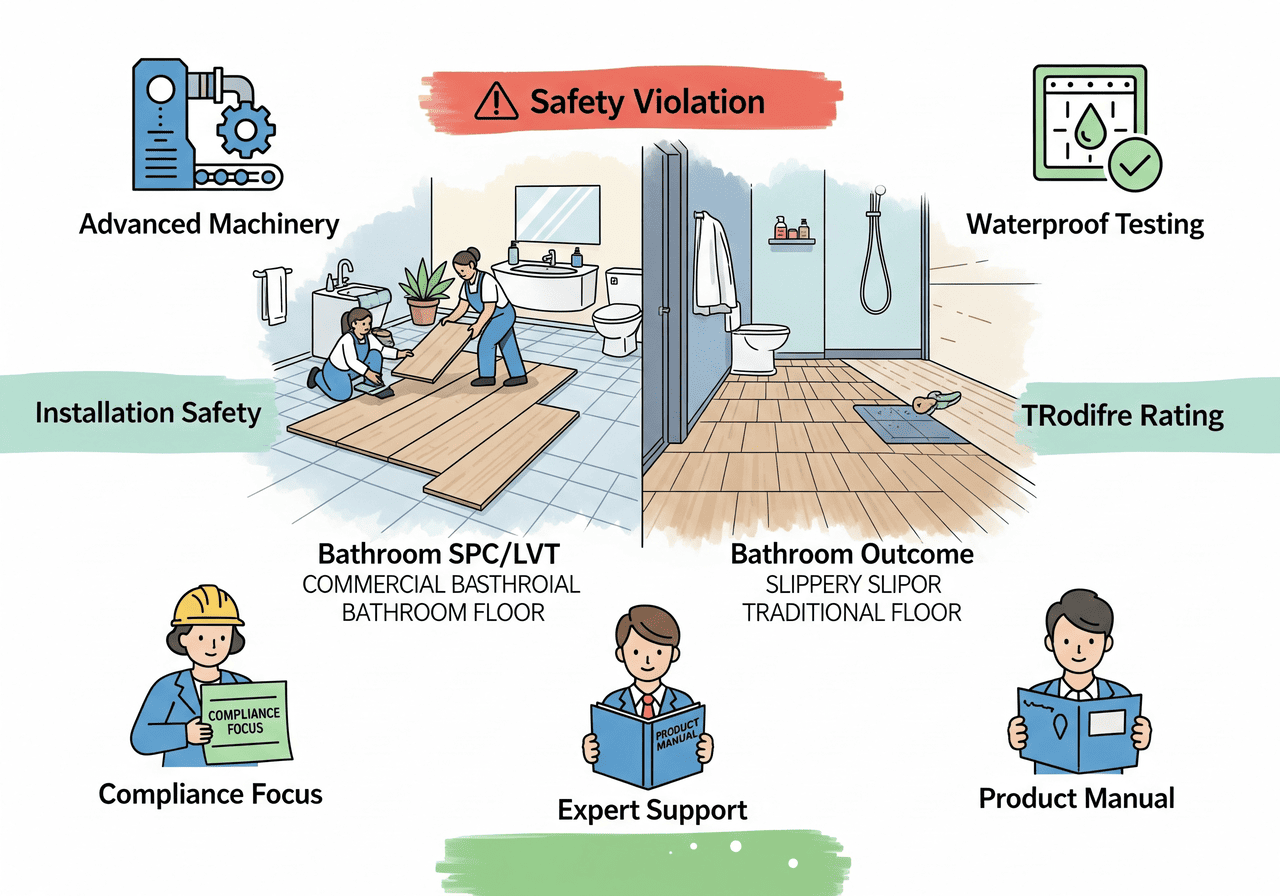
Meeting Commercial Safety Standards
For commercial bathrooms, vinyl flooring is often a top choice. It can meet stringent regulations. These include ADA compliance1 for slip resistance. It also includes specific fire codes. Manufacturers like CloudsFlooring design products to pass these tests. This gives peace of mind to buyers. They know their flooring is safe and compliant.
Flooring must meet slip resistance standards2 to prevent falls in wet conditions. The ADA requires floors to be “slip-resistant.” While no universal dynamic coefficient of friction (DCOF) is specified, the Pendulum DCOF Test (ASTM E303-22) is widely used. A PTV ≥45 is often required for communal shower rooms and ≥55 for external ramps with slopes greater than 1 in 14. The ANSI A326.3 DCOF test also requires a minimum DCOF of 0.42 for indoor wet conditions. This is vital for safety in public spaces.
Commercial floors must have a certain level of slip resistance. This protects users from falls. Look for R-ratings (e.g., R10 or R11) or specific COF values. Public spaces also require flooring that resists fire spread. Vinyl products can achieve Class A fire ratings. This is important for building safety codes. Commercial vinyl needs thick wear layers. These layers protect against heavy foot traffic. They prevent scratches and scuffs. This ensures the floor lasts longer. Commercial bathrooms also use strong cleaning agents. The flooring must resist damage from these chemicals. Vinyl’s top coat helps with this.
Lori, a COO from the United States, works for a company distributing SPC flooring. She is focused on specifications. She needs products that meet all required certifications for her market. Our factory provides these certifications. We understand that our large company buyers need to meet these standards. Compliance with standards like BS EN 16165 (Europe) or AS 4586 (Australia) may be required for international markets. Local building codes and health regulations often mandate fire resistance3 and hygiene standards.
Here is a summary of key commercial features:
| Feature | Importance | How Vinyl Addresses It | Relevant Standard (Example) |
|---|---|---|---|
| Slip Resistance | Prevents falls, ensures user safety | Textured surfaces, high COF/PTV ratings | PTV ≥45, ANSI A326.3 DCOF ≥0.42 |
| Fire Resistance | Reduces fire spread, complies with codes | Achieves Class A fire ratings (for specific products) | ASTM E84 |
| Wear Layer | Withstands heavy traffic, extends lifespan | Thick wear layers (e.g., 20mil, 28mil) | N/A |
| Chemical Resistance | Resists cleaning agents, maintains appearance | Durable protective top coats | N/A |
| Hygiene | Prevents bacteria, meets health codes | Non-porous surface, easy to clean | N/A |
We work hard at CloudsFlooring to make sure our SPC and LVT products are high quality. They can meet global standards. This helps our partners in North America and the UK. They can sell our flooring with confidence.
How Does Waterproof Vinyl Flooring Compare To Alternatives Like Waterproof Laminate For Bathroom Reliability?
Are you confused by all the "waterproof" claims? Do you want to know which flooring truly stands up to water? Understand how vinyl compares to other options.
When choosing bathroom flooring, many products claim to be waterproof. However, there are differences. Waterproof vinyl, especially SPC and LVT, offers superior reliability. It outperforms alternatives like waterproof laminate. Waterproof vinyl appears more reliable than waterproof laminate for bathrooms due to superior water resistance.
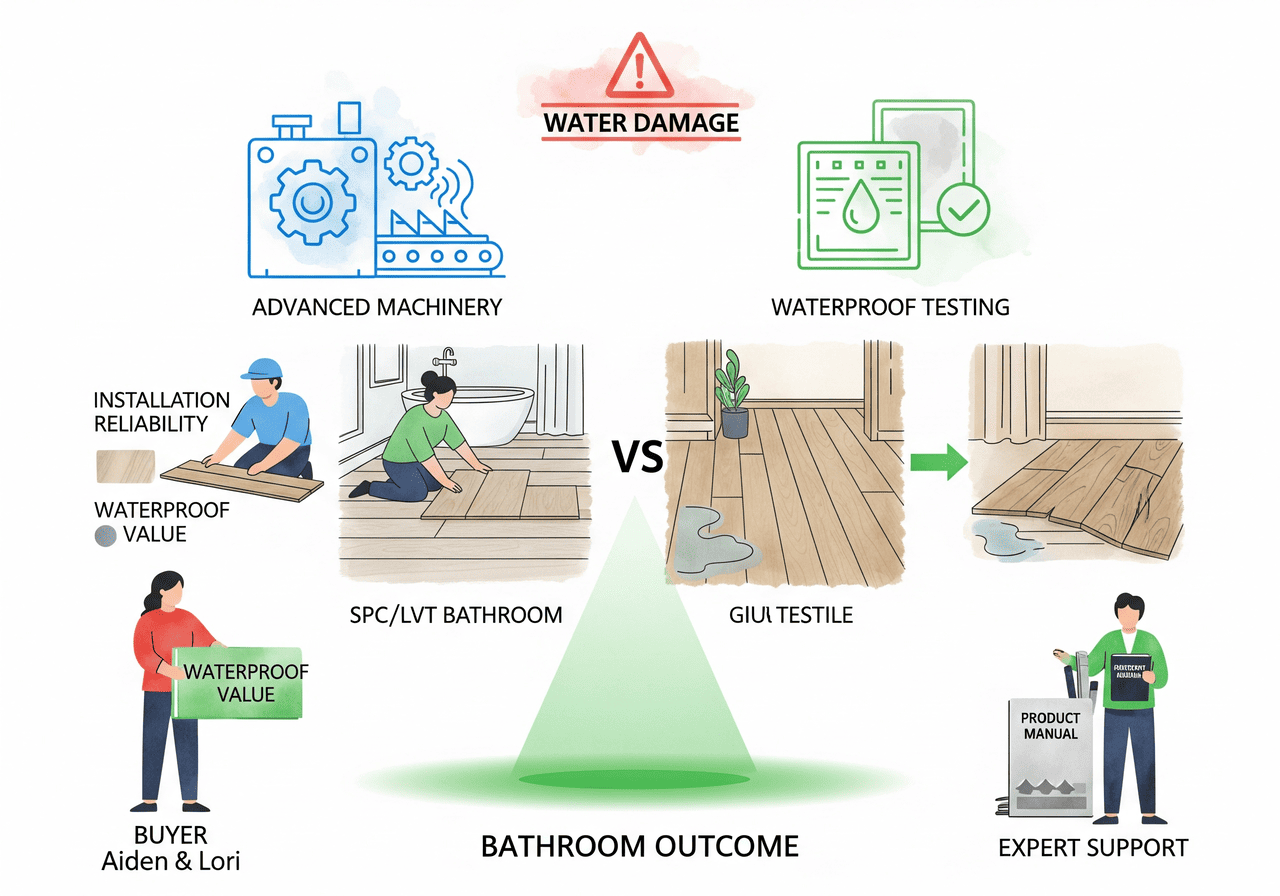
Vinyl vs. Waterproof Laminate: A Head-to-Head
When comparing waterproof vinyl1 flooring to waterproof laminate2 for bathroom reliability, vinyl is generally the superior choice. This is what I tell my clients like Aiden, who are sensitive to quality.
Water Resistance:
- Vinyl Flooring: Vinyl, especially LVP and SPC, is 100% waterproof. It can withstand standing water, spills, and high humidity without damage. The dense core, particularly in SPC, repels water effectively. This means you do not have to worry about the floor buckling if there is a small leak or standing water from a shower.
- Laminate Flooring: Marketed as "waterproof" but typically only "water-resistant." It can handle small spills but may buckle or delaminate with prolonged water exposure. This makes it less reliable for bathrooms with showers or tubs. Its core is often wood-based (HDF – High-Density Fiberboard). This can still absorb water if submerged or if coatings fail.
Durability:
- Vinyl, especially SPC, is highly durable. It resists dents, scratches, and wear better than laminate. Laminate uses a fiberboard core that is more susceptible to moisture damage. Vinyl’s thick wear layers (e.g., 20 mil or 28 mil) enhance its longevity in high-traffic bathrooms. This is a big selling point for distributors like Lori.
Installation:
- Both use click-lock systems. However, vinyl’s waterproof nature makes it more forgiving of minor installation errors in wet environments. Laminate requires precise sealing to prevent water seepage through seams.
Maintenance:
- Vinyl is low-maintenance. It only requires sweeping or mopping, and does not need sealing. Laminate may require more careful maintenance to avoid water damage.
Cost and Longevity:
- Vinyl is often more affordable than high-end laminate. It offers better long-term value in bathrooms due to its superior water resistance3 and durability. For my B2B clients, this means fewer returns and happier customers.
My products are designed for reliability. We know buyers need to trust what they purchase. This focus on true waterproof performance is key to our business model.
Comparison Table: Vinyl vs. Laminate for Bathrooms
| Feature | Waterproof Vinyl (LVP/SPC) | Waterproof Laminate | Reason for Difference |
|---|---|---|---|
| Core Material | Stone/PVC Composite | HDF (Wood-based) | Vinyl’s core is naturally impervious to water. |
| Water Absorption | 0% (Truly waterproof) | Low (but not zero), water-resistant | Laminate’s HDF core can absorb water if seals fail. |
| Standing Water | Excellent (no damage from prolonged exposure) | Poor (can swell/delaminate quickly) | Direct result of core material and construction. |
| Dimensional Stability | Excellent (resists changes from temperature/humidity) | Good (can still shift or expand slightly) | SPC’s rigid stone composite core is highly stable. |
| Durability in Wet Areas | High (resists dents, scratches, moisture damage) | Moderate (susceptible to swelling, delamination) | Vinyl’s top layer and core provide better protection. |
| Maintenance | Low (easy to clean, no sealing needed) | Moderate (requires careful cleaning, avoids standing water) | Vinyl’s non-porous surface is simpler to maintain. |
| Cost | Mid-range to High (for quality) | Mid-range | Quality vinyl offers better long-term value for bathrooms. |
Vinyl’s superior waterproofing and durability make it the more reliable choice for bathroom environments.
Conclusion
Choosing the best bathroom flooring means picking 100% waterproof vinyl like SPC or LVT. It offers safety, hygiene, easy care, and diverse designs. Proper installation ensures long-term reliability. Vinyl outperforms other options for wet areas due to its inherent waterproof nature.
The above data is for reference only.
-
Explore the advantages of waterproof vinyl flooring, especially its durability and water resistance, making it ideal for bathrooms. ↩ ↩ ↩ ↩ ↩ ↩ ↩
-
Learn about the limitations of waterproof laminate compared to vinyl, especially regarding water resistance and durability. ↩ ↩ ↩ ↩ ↩
-
Discover why water resistance is crucial for bathroom flooring and how it affects longevity and maintenance. ↩ ↩ ↩ ↩
